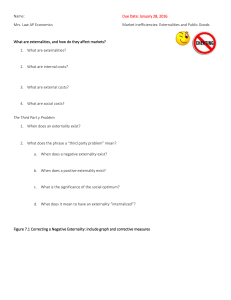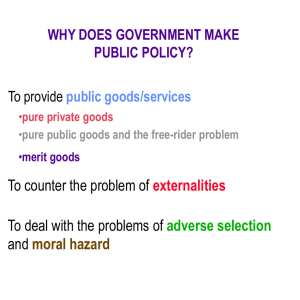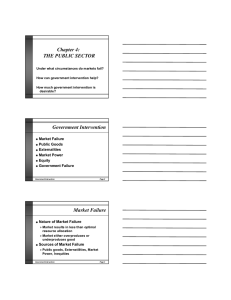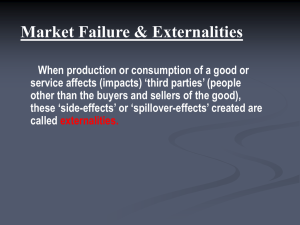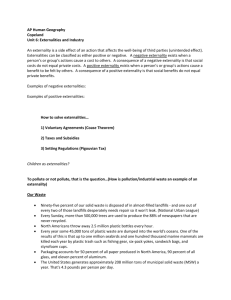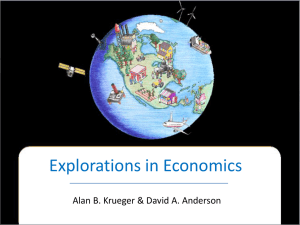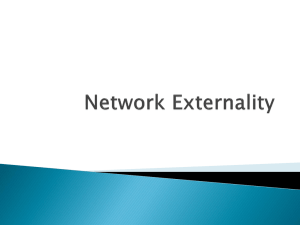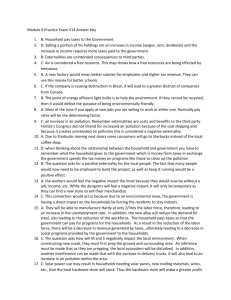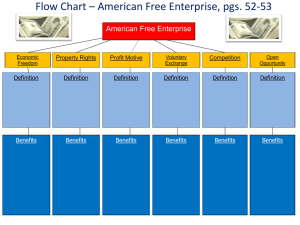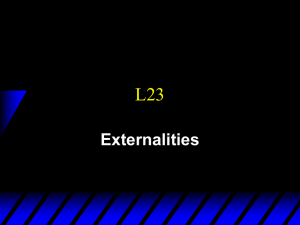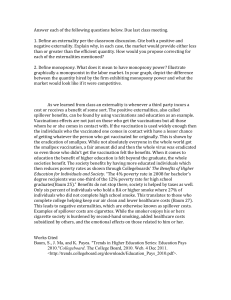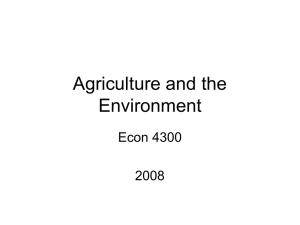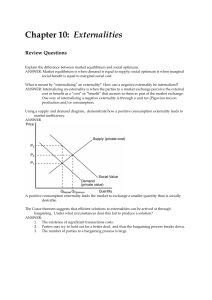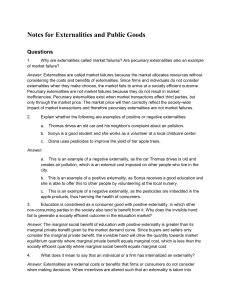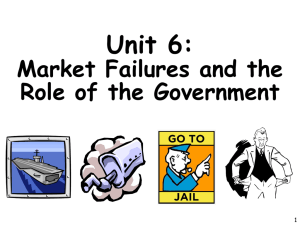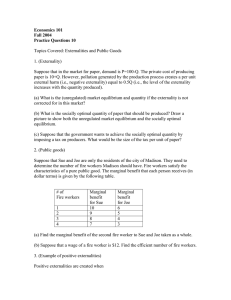Monitoring - nexus: David Levinson's Networks, Economics, and
advertisement
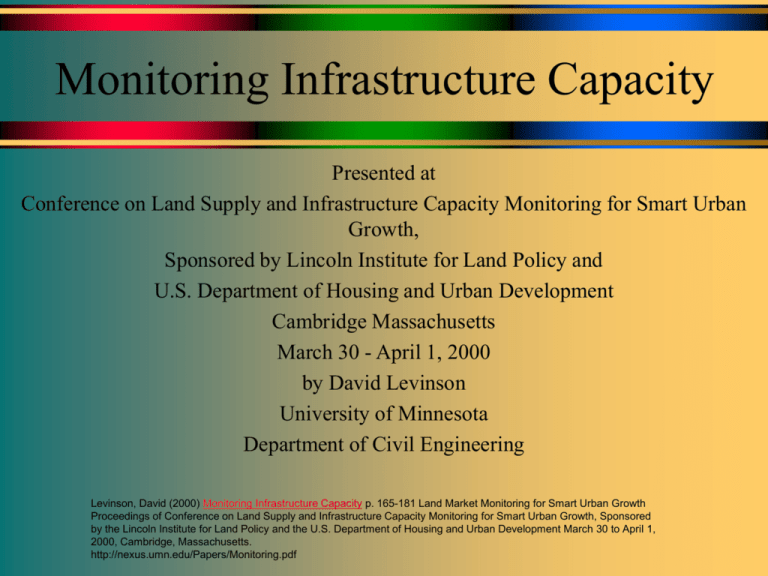
Monitoring Infrastructure Capacity Presented at Conference on Land Supply and Infrastructure Capacity Monitoring for Smart Urban Growth, Sponsored by Lincoln Institute for Land Policy and U.S. Department of Housing and Urban Development Cambridge Massachusetts March 30 - April 1, 2000 by David Levinson University of Minnesota Department of Civil Engineering Levinson, David (2000) Monitoring Infrastructure Capacity p. 165-181 Land Market Monitoring for Smart Urban Growth Proceedings of Conference on Land Supply and Infrastructure Capacity Monitoring for Smart Urban Growth, Sponsored by the Lincoln Institute for Land Policy and the U.S. Department of Housing and Urban Development March 30 to April 1, 2000, Cambridge, Massachusetts. http://nexus.umn.edu/Papers/Monitoring.pdf Outline Complexity of Problem Carrying Capacity Theory Externality Theory Measures of Effectiveness The Complexity of the Problem Infrastructure capacity absorption depends on underlying technology and a development’s: location, timing, density, and character Infrastructure serves multiple uses and users Multi-dimensional A flow bundle of attributes not a stock May have a “capacity” or a “standard” Planning Process Monitoring Master should be linked to plans Capital Improvement Programs Financing System Development Regulation Infrastructure and Development Over Time under Carrying Capacity Theory Private Population Need Large Increment of Change Publi c Facilit y Capacit y Growth Points of Perfect Balance Time Tolerance Externality Theory An externality is “a commodity bundle that is supplied by an economic agent to another economic agent in the absence of any related economic transaction between the two agents. (Spulber).” Arise from lack of property rights. May be positive or negative. Positive include consumption externalities and network externalities. Negative include congestion, pollution, accidents, etc. First Best Solution: Internalize Externality: Polluter Pays Principle. Transactions costs may make internalization difficult. Desired Outcomes of the Transportation System (Caltrans) Outcome EFFECTIVENESS AND EFFICIENCY Mobilit y/ Accessibilit y Relia bilit y Cost-Effectivenes s RESPONSIBILITY Sustainab ilit y Envi ronmental Qualit y Safety and Securit y Equi ty Customer Satisfaction Econo mi c Well Being Candid ate Measure s Travel Time, Delay, Access to Desir ed Locations, Access to System Variabilit y o f Travel Tim e Benef it/ Cost Ratio, Outcome Benefit per Cost Househo ld Transpo rtation Costs Nationa l and State Standa rds Accident and C rime Rates Benef its per Inco me Group Customer Surv ey Final Demand (Value of Transportation to the Econo my) Measures of Effectiveness (MOE) Second-Best Solution: Regulate Developer Infrastructure Has Multiple Attributes - A Doctor Looks at More Than Temperature, Planners Should Consider More Than Capacity The Right MOE’s Vary Based on Facility Being Analyzed, MOE’s Should Consider Not Only Current Status of System, but also Its Direction of Change. Attributes of Good Measure of Effectiveness Complete Aggregates Well Aligns with User Experience Measurable Predictable Useful in Regulatory Context Criteria for Selecting Measure of Effectiveness It aids in identifying opportunities to increase the systemwide net benefits through public investment in improvements or changes in management, It minimizes the cost to achieve necessary measurement accuracy, and It produces the right incentives. Measure of Effectiveness for Transportation: Consumer’s Surplus x Time y z TB TU TA SU f e gh i j SI k l DB DU DA QU QA QB Traffic Flow (Q) Data Sources and Collection Supply Data Measured - Engineering Cost Study Predicted - Statistical Cost Study (Many Projects) Demand Data Measured - Operating Agency Utilization Data Predicted - Statistical Forecasts Second Best Development Regulation: Minimizes the Cost of: Prevention (Build) The cost of infrastructure required to maintain the performance indicators (Engineering or Statistical), or (Manage) The cost of demand and supply management to maintain the performance measures. Damage (Accept) The cost to the community of worsening the performance indicators in the absence of the infrastructure. An Example of Benefit Cost Comparisons Deve lopment Approve Subs idy Positi ve <=== 0 ===> Negative Infrastructure Infrastructure Disapprove outrigh t Buil d No Buil d Build No Build Deve lopment Approve Approve uncond iti ona lly w/construc tion -$200,000 $800,000 -$400,000 -$400,000 Disapprove outrigh t -$200,000 0 Summary Externalities Provides Underlying Rationale for Development Regulation Unfortunately, “First Best” Solution (P=MC) is Not Always Feasible Regulating Supply is a “Second Best” Solution Multiple Measures of Effectiveness are Required to Understand Impact of Development on Capacity Utilization Conclusions Select Measures of Effectiveness Collect and Forecast Data Establish Standards (Absolute or Relative) Open System to Peer Review and Public Scrutiny Answer Not Whether Development, But How Implement Monitoring System in Regulation


